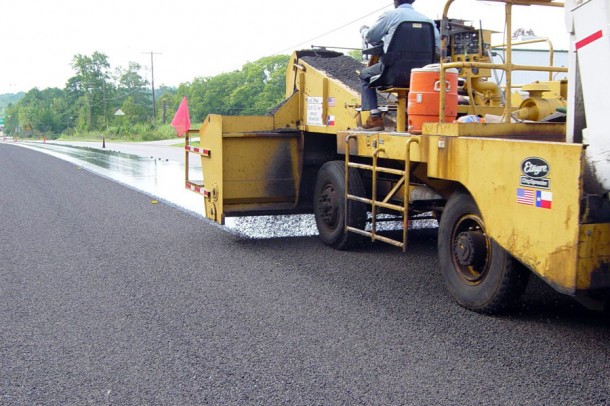Other road preservation methods can cost seven to ten times more than a seal coat.
What’s the Problem?
To extend the life of a road, water penetration must be controlled. Seal coats excel in keeping water from reaching the roadway base and have been a cost-effective method of roadway rehabilitation for the Texas Department of Transportation (TxDOT) for many years. Some motorists and homeowners have questioned the effectiveness of the procedure due to the perceived loudness of the finished surface. They believe it is a cheap, ineffective maintenance technique instead of a proper surface repair. Bicyclists complain about the difficulty of riding on shoulders with seal coat applications.
What’s the Solution?
Texas A&M Transportation Institute (TTI) pavement researchers measured seal coat noise levels from multiple locations in Texas. Additional noise level testing was conducted on specially constructed test sections. Researchers also looked at the longevity of different seal coat applications.
Although researchers determined that seal coats tend to be noisier than other types of pavement, in many cases the difference in noise level is so small that the human ear can’t tell the difference. Some concrete pavements, for example, measured just as loud as a seal coat. In most cases, smaller aggregate makes for a quieter seal coat surface. Smaller aggregate also makes bike riding on shoulders easier. Many TxDOT districts are now placing smaller aggregate on shoulders while larger, more durable aggregate is being placed in main travel lanes.
Seal coat longevity depends on many factors. The condition of the road prior to seal coating has a great deal to do with durability. Higher traffic counts shorten the life of seal coats. Climate plays a role, too, with cooler temperatures extending seal coat life. Researchers developed a set of guidelines to assist TxDOT districts with best practices in seal coating.
Benefits
Texas has more miles of non-city roadways than any other state. Given limited resources and personnel at TxDOT, these roads must be maintained in the most cost-effective manner possible. John Bohuslav, director of maintenance for TxDOT’s San Antonio District, notes that 10,000 miles of roads cross the San Antonio District alone. Other road preservation methods can cost seven to ten times more than a seal coat.
“A road that needs a seal coat may look fine to the average driver, because they don’t get out and look at the surface. Because of the number of miles of road TxDOT must maintain, the agency can’t afford to use costlier methods. When dealing with low-traffic roads, a seal coat is the best choice,” Bohuslav says.
The results of this project validate TxDOT’s use of seal coats and provide guidelines regarding aggregate choice. Using these guidelines can help TxDOT maintain roads effectively while, at the same time, using resources and personnel most efficiently for the state as a whole.
Project Title
Quantifying the Effects in Order to Optimize the Use of Grade 3 and Grade 4 Seal CoatsProject Number
0-6496
Project Sponsor(s)
Texas Department of Transportation
Project Category
Infrastructure
Project Termination Date
August 2012
Project Publications
For More Information
Cindy K. Estakhri, P.E.
Research EngineerRecyclable Materials
Texas A&M Transportation Institute
The Texas A&M University System
3135 TAMU
College Station, TX 77843-3135
Ph. (979) 317-2308
c-estakhri@tamu.edu
